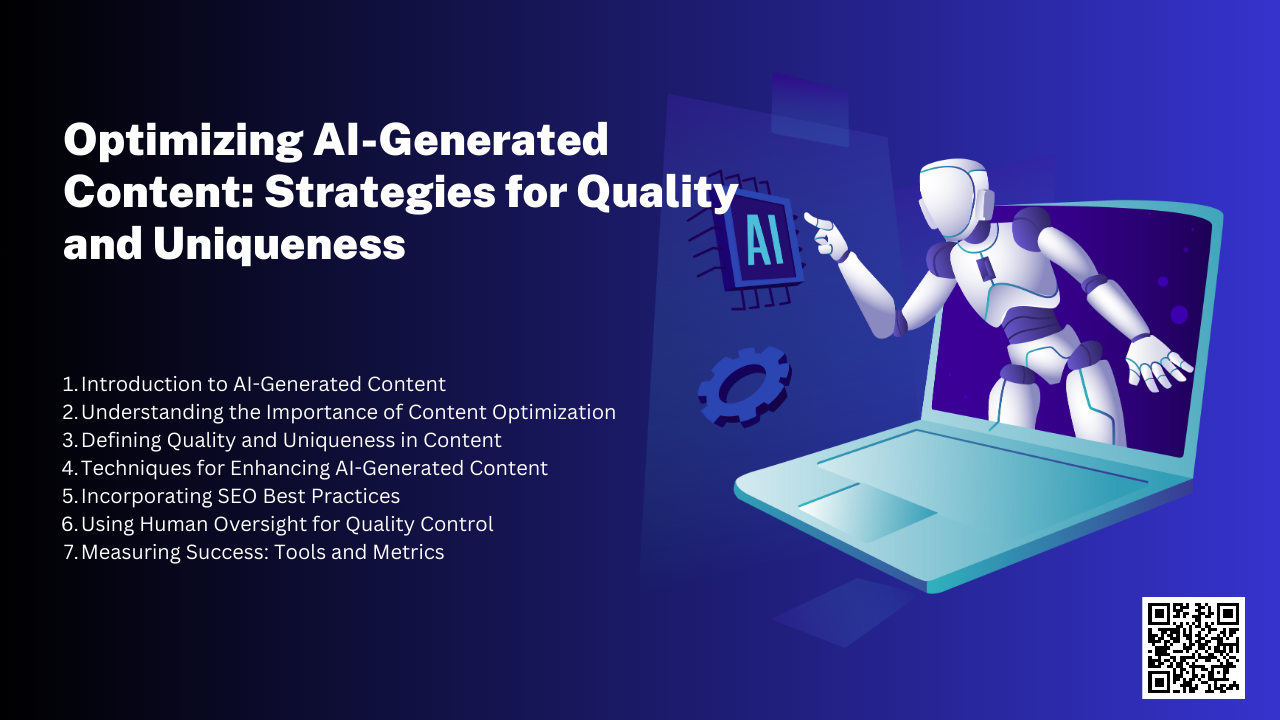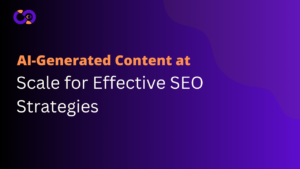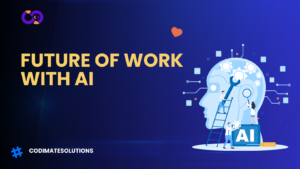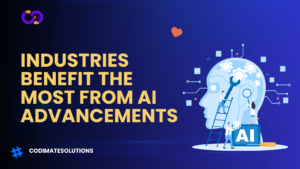- Introduction to AI-Generated Content
- Understanding the Importance of Content Optimization
- Defining Quality and Uniqueness in Content
- Techniques for Enhancing AI-Generated Content
- Incorporating SEO Best Practices
- Using Human Oversight for Quality Control
- Measuring Success: Tools and Metrics
- Addressing Ethical Considerations
- The Future of AI in Content Creation
Introduction to AI-Generated Content
The evolution of artificial intelligence has significantly transformed various industries, particularly in the realm of content creation. AI tools such as ChatGPT, GPT-4, and Bard have emerged as prominent solutions, showcasing remarkable capabilities in generating coherent and contextually relevant text. These advancements have opened up new avenues for content creators and marketers, enabling them to produce quality material with increased efficiency and scalability.
The significance of AI-generated content in today’s digital landscape cannot be overstated. As online information consumption continues to rise, the demand for fresh and engaging content is more critical than ever. AI-based platforms can analyze vast amounts of data, allowing them to understand language patterns and context effectively. This leads to the generation of content that resonates with target audiences while also maintaining a unique voice and tone. Consequently, businesses and marketers are increasingly leveraging these tools to enhance their content strategies.
Furthermore, the growing prevalence of AI-generated content reflects the broader trend of automation in various sectors. Content creators now have the opportunity to utilize AI to streamline various tasks, from drafting proposals to creating blog posts and social media updates. By doing so, they can focus on higher-level strategic thinking and creativity, ultimately improving their productivity and output quality. However, it is also essential to recognize the limitations of these tools. While AI can generate text, the human touch remains crucial to ensure authenticity, emotional engagement, and originality.
As we delve deeper into the strategies for optimizing AI-generated content, understanding the foundational capabilities of these tools will help content creators harness their full potential, ensuring quality and uniqueness in an increasingly AI-driven world.
Understanding the Importance of Content Optimization
In the digital age, content optimization has become an indispensable aspect of online visibility, particularly concerning AI-generated content. Google’s algorithms are continuously evolving, aimed at delivering high-quality and relevant results to users. As a result, it is essential for content creators and businesses utilizing AI tools to understand how content optimization plays a pivotal role in achieving favorable search engine rankings.
Google employs several ranking factors to assess the quality of content, including relevance, originality, and user engagement metrics. Optimizing AI-generated content ensures not only compliance with these algorithms but also enhances user experience, which can lead to increased traffic and conversions. Failure to prioritize content optimization can pose significant risks, including possible penalties that may affect a website’s visibility and overall performance in search results.
Moreover, low-quality content, even if generated efficiently by AI, can lead to detrimental consequences. Google has implemented measures to identify and penalize spammy and unoriginal content, thereby impacting businesses and content creators who rely heavily on these tools. The implications of such penalties are dire; they can lead to reduced trustworthiness and authority in the eyes of both search engines and potential customers.
In this context, the importance of refining AI-generated content cannot be overstated. By optimizing for search engines and ensuring that the content meets the expectations of the target audience, businesses can foster a competitive edge in a crowded market. Ultimately, content optimization is not merely a technical necessity but a strategic imperative that can influence a business’s long-term success.
Defining Quality and Uniqueness in Content
Quality and uniqueness are fundamental aspects of content that significantly influence user engagement and satisfaction. High-quality content is defined by its ability to provide valuable information that is relevant, accurate, and engaging to the target audience. Essential characteristics of quality content include depth of research, clarity of expression, and an authoritative tone that boosts its credibility. Furthermore, it should be structured logically, using headings and bullet points where necessary to enhance readability.
Uniqueness, on the other hand, refers to the originality of content. This is not only about avoiding plagiarism but also involves presenting ideas in a new light or from a distinct perspective. Unique content tends to attract more attention in a crowded digital landscape, as users are increasingly seeking fresh insights and experiences. It sets the stage for a strong connection between the content creator and the audience, fostering trust and loyalty.
AI tools can assist in generating content of high quality and uniqueness by harnessing vast amounts of data and analyzing trends. By employing algorithms, these tools can suggest topics that resonate with users or recommend various angles to approach specific themes, thereby encouraging originality. Moreover, AI can help in editing stages to ensure that the content is free from redundancy and maintains a cohesive structure, all while avoiding plagiarism through careful paraphrasing and citation practices.
Incorporating best practices such as keyword research can further optimize AI-generated content, aiding in its discoverability on search engines. By blending the efficiency of AI with comprehensive content strategies, creators can produce material that excels in both quality and uniqueness, ultimately enhancing user experience and engagement.
Techniques for Enhancing AI-Generated Content
Enhancing AI-generated content requires a multifaceted approach that seeks to improve the overall quality while also ensuring originality. One effective technique involves incorporating personal insights. By adding unique perspectives or experiences related to the subject matter, writers can create a more authentic narrative that resonates with readers. Personal anecdotes not only enrich the content but also provide context that an AI may not capture.
Additionally, adjusting the tone and style of the content is critical. AI often generates text that is either overly formal or lacks a particular voice. Writers should assess the target audience and modify the language, pacing, and structure accordingly. For instance, a more conversational tone may be more effective for a lifestyle blog, while a scholarly tone is preferable for academic articles. This adjustment ensures that the content aligns with the expectations and preferences of its intended readers.
Moreover, maintaining factual accuracy is essential in elevating the quality of AI-generated content. While AI can assist in generating ideas and drafts, it may not always be reliable in terms of sourcing accurate data. Writers are therefore encouraged to verify facts, provide citations where necessary, and incorporate up-to-date information. This will not only enhance the credibility but will also demonstrate a commitment to delivering high-quality content.
Another technique for refinement is the use of editing tools and software designed to improve readability. Tools like Grammarly and Hemingway can assist in identifying areas where the text may be convoluted or unclear, further enhancing the final output. By combining these various techniques—adding personal insights, adjusting tone, ensuring factual accuracy, and utilizing editing software—writers can significantly improve the quality and uniqueness of AI-generated content.
Incorporating SEO Best Practices
One of the primary objectives of producing AI-generated content is to ensure it not only resonates with readers but also ranks effectively in search engine results. To achieve this, the integration of SEO best practices is essential. The first step in this process is to conduct thorough keyword research. Utilizing tools such as Google Keyword Planner or SEMrush can help identify relevant keywords and phrases that your target audience frequently searches for. By understanding the intent behind these keywords, you can create content that aligns with user expectations while naturally incorporating these terms.
In addition to keyword research, crafting compelling meta descriptions and title tags is crucial. The meta description serves as a brief overview of the content, appearing beneath the title in search results, influencing click-through rates. It should be concise and include primary keywords, ideally within 160 characters. The title tag, which is the clickable headline that appears in search results, must also reflect the content accurately while incorporating the main keyword early in the text to optimize its visibility.
Content structure plays a pivotal role in enhancing readability and engagement. Breaking up the text into smaller paragraphs, using bullet points, and incorporating headers not only improves user experience but also makes it easier for search engines to parse the content. Engaging multimedia elements, such as images and videos, can enhance the overall effectiveness of the content. When utilized effectively, these elements can enrich the reader’s experience and can also be optimized with descriptive alt text that includes relevant keywords.
Furthermore, ensuring that the content is unique and free from plagiarism is paramount. Search engines prioritize original content providing fresh insights or perspectives. By combining high-quality, AI-generated content with robust SEO strategies, creators can enhance their visibility and engagement rates, ultimately ensuring the content achieves its intended impact.
Using Human Oversight for Quality Control
In the era of artificial intelligence, the automation of content creation has gained significant traction. However, the necessity of human oversight remains paramount to ensure the output meets quality standards and aligns with the intended brand voice. Editors and content strategists play a crucial role in evaluating AI-generated content, bringing invaluable insights that AI tools cannot replicate. Their expertise assists in refining the output, providing the emotional and contextual nuance often needed to resonate with the target audience.
Human oversight includes critical tasks such as proofreading, fact-checking, and contextual review. These processes are essential in identifying errors, inconsistencies, and areas where the content may diverge from audience expectations. By involving skilled editors, organizations can maintain control over the narrative and ensure that the content produced by AI serves the strategic goals of the brand. This involvement is particularly significant when integrating nuances of language that AI may overlook, such as idioms, cultural references, or tone alterations that might better connect with specific demographic groups.
Moreover, editors can impose a layer of creativity that AI lacks, enabling the development of unique angles or compelling narratives that enrich the reader’s experience. This collaborative synergy between human expertise and AI efficiency can yield content that is not only high-quality but also distinctive. Regular evaluations and feedback from human overseers can guide improvements in AI tools, enhancing their future performance and usefulness in generating content.
In conclusion, while AI tools provide efficiency, human oversight is essential in the content creation process. The combined efforts of skilled editors and content strategists allow for the production of high-quality, engaging, and relevant content that meets the demands of both brands and their audiences.
Measuring Success: Tools and Metrics
To effectively assess the performance of AI-generated content, it is crucial to utilize various tools and metrics that facilitate a comprehensive analysis. These metrics serve as vital indicators of engagement, traffic, and conversion rates, enabling content creators to understand how well their optimized material resonates with the target audience.
One of the primary tools for measuring success is web analytics software, such as Google Analytics. This tool offers insights into key traffic metrics, including page views, session duration, and bounce rates. By analyzing these data points, writers can determine how users interact with AI-generated content. Furthermore, tracking user behavior can uncover trends regarding which types of content attract the most engagement, thus informing future optimization strategies.
In addition to traffic metrics, conversion rates provide another critical measurement of success. Tools such as HubSpot or ClickFunnels allow content creators to monitor the number of leads generated, sign-ups, or purchases resulting from their AI-generated content. A high conversion rate indicates that the content effectively meets the needs of the audience, while a lower rate may signal a need for further refinements.
Social media engagement metrics should also be considered, including shares, likes, and comments on platforms like Facebook, Twitter, and LinkedIn. Utilizing social listening tools, such as Hootsuite or Sprout Social, can provide valuable insights into how well the content is received by the community. This feedback loop not only aids in measuring immediate success but also helps in shaping future content direction. Overall, integrating a combination of these tools and metrics offers a holistic view of the effectiveness of AI-generated content, paving the way for ongoing improvements.
Addressing Ethical Considerations
The integration of artificial intelligence (AI) in content generation gives rise to several ethical issues that warrant careful examination. One significant concern is copyright infringement, as AI systems often rely on large datasets that include copyrighted material for training. This raises questions about the ownership of the generated content. If an AI model produces text based on pre-existing works, it may inadvertently replicate proprietary elements, leading to potential legal repercussions for content creators who utilize these systems. Thus, understanding and navigating copyright law becomes essential for anyone leveraging AI-generated content.
Another critical aspect to consider is authorship. With the rise of AI, the traditional notion of authorship may be at risk of transformation. Who should be credited for AI-generated work—the developer of the AI, the individual who prompted the AI, or the AI itself? This ambiguity complicates the ethical landscape of content creation. Creators must adopt clear practices that establish transparency in relation to the source and nature of the content they produce. This includes disclosing the involvement of AI technologies in the content creation process, thereby building trust with the audience and maintaining integrity.
Moreover, ethical responsibilities extend to the accountability of content creators in ensuring that AI-generated materials adhere to community standards and values. This includes being vigilant against the risk of disseminating misinformation or biased content that may arise from flawed AI training data. Professionals must critically assess the outputs generated by AI, applying their own judgment to enhance quality and relevance while safeguarding against harmful narratives. Engaging in ongoing education about the implications of AI in content creation can be invaluable. By doing so, creators not only uphold ethical standards but also contribute to a more responsible and trustworthy information ecosystem.
The Future of AI in Content Creation
The landscape of content creation is on the cusp of significant transformation driven by advancements in artificial intelligence (AI). As AI technology continues to evolve, we can expect an increase in its prevalence in content marketing strategies. Companies are increasingly utilizing AI tools to generate high-quality content that not only attracts engagement but also meets the rising expectations of audiences for relevance and personalization.
Advancements in natural language processing (NLP) algorithms are particularly noteworthy. These improvements enable AI systems to better understand context and nuance, resulting in content that feels more human-like. Thus, content creators may find that their role shifts from production to curation and strategy. In this new paradigm, human oversight will remain crucial for ensuring content aligns with brand voice and audience intent.
Moreover, as content optimization techniques become increasingly sophisticated, we anticipate that AI will facilitate the creation of highly tailored content. This means content can be generated based on data-driven insights about audience preferences. For instance, platforms might integrate AI tools that analyze user interactions in real-time, allowing for seamless adjustments to content strategies and ensuring relevancy.
In addition, advancements in AI technologies may lead to a more competitive landscape. Content creators will need to embrace these tools to keep pace with evolving industry standards. The prospect of increased AI utilization raises questions about originality and ownership, compelling creators to focus on developing unique perspectives and insights that resonate in a crowded market.
Finally, regulatory considerations are likely to emerge, prompting discussions around ethical implications and the definition of authorship. As we look to the future, it is clear that AI will play an increasingly vital role in content creation and optimization, shaping both the tools available and the strategies employed by content marketers. In conclusion, staying informed about these developments will be essential for content creators aiming to thrive in this dynamic environment.




